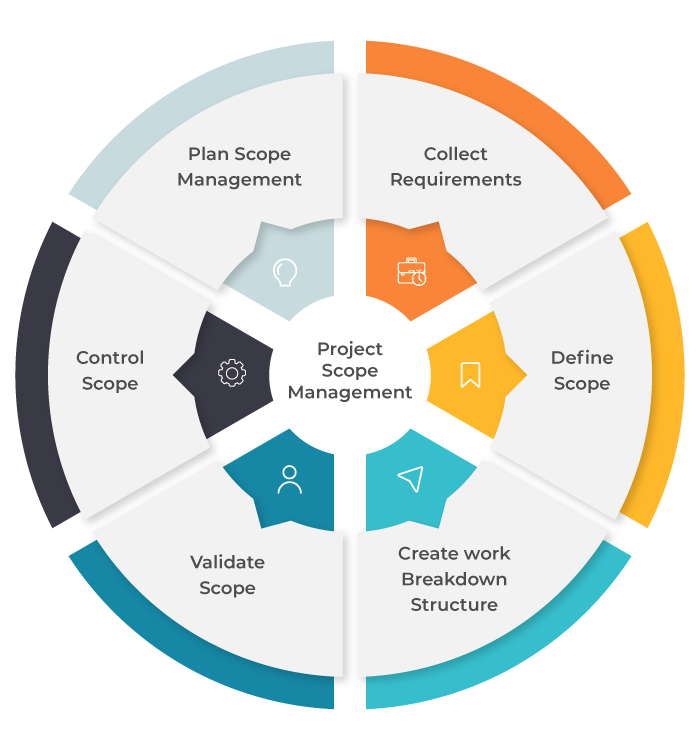
- Project scope management is a process that helps in determining and documenting the list of all the project goals, tasks, deliverables, deadlines, and budget as a part of the planning process. In project management, it is common for a big project to have modifications along the way.
- Project Scope is the work that needs to be accomplished to deliver a product, service, or result with the specified features and functions. Scope refers to the detailed set of deliverables or elements of a project; these deliverables are derived from a project’s requirements.
- With the scope in the project management defined right in the beginning, it becomes much easier for teams to manage and make the required changes.
Project Scope Management Definition
Project Scope Management is the process to ensure that a particular project includes all the work relevant/appropriate to achieve the project’s objectives. Its primary aim is to control what is and is not involved in the project. The Scope Management techniques enable project managers and supervisors to allocate just the right amount of work necessary to complete a project.
Scope statement in project management
- The project scope statement is also called scope document or the statement of work and it details all the boundaries of the project while also establishing the responsibilities of the team.
- An example of a project scope statement is that it defines all the procedures that need to be followed for verifying and approving the finished work. The scope statement documentation gives team members a definitive guideline for making project-related decisions.
- When documenting the scope of a project, team members and stakeholders have to be as specific as possible to avoid scope creep, a situation where some parts of the project end up taking more time and effort than initially discussed due to miscommunication or poor planning.
- With effective project scope management, teams are able to ensure that the project is finished by the set deadlines and the final product aligns with the initial requirements.
- Scope management ensures a project’s scope is accurately defined and mapped and enables project managers to allocate the proper labor and costs necessary to complete the project. This is primarily concerned with what is and is not part of the scope. The three processes involved in project scope management are:
- Planning: This includes capturing and defining the work that needs to be done
- Controlling: This step focuses on scope creep, documenting, tracking and approving/disapproving of changes
- Closing: This includes an audit of the project deliverables and assessing the outcomes of the original plan
- Another critical component for scope management involves defining the scope in a statement. Once the processes are understood, a document must be drawn up to delineate the project.
Importance of project scope management
For a project manager, managing the expectations of the stakeholders and clients is one of the most challenging tasks. With a definite project scope, managers can easily stay on track and ensure that all the deadlines are being followed throughout the project life cycle.
A well-defined project scope management helps avoid common issues like:
- Constantly changing requirements
- Pivoting the project direction when you are already mid-way
- Realizing that the final outcome isn’t what was expected
- Going over the discussed budget
- Falling behind the project deadlines
- Effective project scope management gives a clear idea about the time, labor, and cost involved in the project. It helps to distinguish between what is needed and what isn’t needed for accomplishing the project.
- Scope in project management also establishes the control factors of the project to address elements that might change during the project lifecycle.
- Managing the expectations of clients and stakeholders can be one of the most difficult tasks a project manager can face. With a distinct scope, it helps everyone to stay on the same page throughout the life cycle of the project. A well-defined scope can help to avoid common problems like:
- Requirements that constantly change
- Requirements that need a rethink mid-project
- The final outcome not being what the client expected
- The budget overrunning
- The project is way behind schedule
- Effective scope management can help to avoid some of these issues by clearly defining and communicating the scope to all parties involved in the project. Project scope helps to distinguish what is and is not involved in the project and controls what is allowed or removed as it is executed. Scope management establishes control factors, that can be used to address elements that result in changes during the lifecycle of the project.
- Project scope is critical because without it project managers would have no clue what time, cost or labor was involved in a project. It forms the basis for every decision a project manager will make on a job and when it needs to change, proper communication will ensure success every step of the way.
THE PROCESSES OF PROJECT SCOPE MANAGEMENT

1. Plan:

With the help of meetings, discussions and historical data from past projects, you come up with a scope management plan. The plan describes how the scope will be defined, developed, controlled, monitored and evaluated.This plan should ideally include all of the following: – What will be the process for preparing the scope statement?- How a Work Breakdown Structure (WBS) will be created from the scope statement?- How will it be approved and maintained?- How will the project deliverables be formally approved?- How will changes to the scope be managed?Remember, your plan shouldn’t be anything formal or fancy. It is there to make your processes easy and so make it according to your needs – be it detailed or brief.
2. Collect Requirements:

Sometimes, it so happens that your client has given you all the basic details of what kind of software they require. You keep on working at the same for 2 months, putting in talented developers, designers and so on. At the end of 2 months, when you submit the software, they tell you that the cost is too high.Now, you either have to scrap the project or waste unnecessary time in removing certain features and functionalities to make it cost-friendly. Many times, it also happens that the client gives you the cost and basic requirements details, but at the end they don’t like the interface and so on.To avoid this and similar issues to crop up at the end, get every small detail from the client and even the key stakeholders.In the end, you will have a document containing all those requirements and it should at least include – functional, reporting, approval, quality, training, service, business and approval requirements.In case of big and detailed projects like construction projects, you will also need to deal with environmental regulations, procedures and the like.You can go one step further and also note down all the assumptions and constraints mentioned by either the client or your team for certain requirements.
3. Define:

When you have collected all your requirements, at this stage you compile them and prepare a scope statement. This will give a detailed description of the outcome/product /service that the project is going to create.It is also recommended to note all the exclusions i.e. all the things that you will not be providing. For example, your project is about making a customized software for the company. You normally create that kind of software with features 1, 2, 3, 4, and 5. But due to cost constraints, you have to skip features 4 and 5.Including all the exclusions will keep the team guided on what not to spend their time on.
4. Create Work Breakdown Structure (WBS):

When you know the details of all your requirements, create a Work Breakdown Structure. What this essentially means is that you break large tasks into smaller, manageable ones.For example, one part of your project is to deal with getting a permit. You further break it down: Task A – Getting the research and document ready by the legal teamTask B – Getting it approved by the CEOTask C – Getting all the supporting documents ready by the administration teamTask D – Filing it onlineWith the help of a task management software, you can easily assign those tasks to your team members and set dependencies. You can also list down all the details like due dates, tools required, expenses and so on for individual tasks.
5. Validate Scope:

Once your project deliverables are set, you need approval for the same from the client or customer. Not only that but also in this stage, you note down how that process would take place.For example, if you need to get approval from your clients for every feature that you produce, list down the key person from the client’s team whom you should reach out to. It’s also recommended to list down the criteria the client team has for approving/disapproving the feature. At the end of this stage, you will have deliverables accepted by whoever needs to approve them.
6. Control Scope:

This process forms a part of project monitoring. Controlling scope is all about monitoring the status and managing project scope such that changes can be made if and when required.It helps in avoiding scope creep. Scope creep is what happens when changes to a project are made without any control. A study by PMI shows that 52% of the projects completed over a period of one year experienced scope creep which is a 43% increase from that reported 5 years ago.This stage helps in avoiding budget overruns, wasting your time and effort because of improper planning. It helps in creating a revised scope statement and work breakdown structure according to the changes happening.





